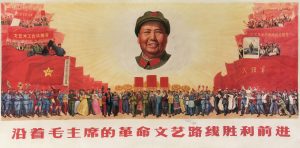Mao’s China, c.1930–1976
Mao ruled China from 1949 until his death in 1976. His rule saw the ‘Greap Leap Forward’ and the Cultural Revolution. His rise began in the early 1920’s as a founder member of the Chinese Communist Party. The CCP engaged in a long Civil War against the Nationalists. On the verge of defeat, Mao led the CCP on the ‘Long March‘ to the North of China. The CCP under Mao were allied with the Nationalists in the war against Japan, 1937-1945. However civil war broke out between the two shortly after Japan’s defeat. In 1949, the Communists were victorious. Mao became the leader of China and their opponents, the Nationalists, fled to Taiwan.
China under Mao was transformed. Industry fell under state control. Farms were reorganised into Collectives. Population size was placed under control with the introduction of the one child policy. The CCP suppressed all opposition, this was a dictatorship. China’s new Communist leadership asserted it’s authority internally and externally quickly. Mao Zedong’s policies saw the execution of many landowners and the opening of the laogai camp system.
China became involved in the Korean War in 1950. A large number of ‘People’s Volunteers’ aided Communist North Korean forces against the South Korean and American forces. Despite heavy losses the outcome was a stalemate, with the two sides agreeing an armistice in 1953. The leadership also ordered the invasion and annexation of Tibet in 1950. By the 1960’s China was developing new weapons systems and in 1964 became the 5th nation to have a nuclear capability.
Mao as leader
Mao’s regime aimed to reduce bureaucracy in Chinese Government. The Hundred Flowers Movement had this aim. However, many took it as an opportunity to criticise the regime and it led to a purge of the party. The Party continued to adhere to his vision of a Marxist state and was fiercely protective of it’s independence. This led to frosty relations with the Soviet Union. As Khruschev introduced De-Stalinisation in the USSR, Mao praised Stalin and had large portraits of him placed on display. The Chinese Communist government also decline Soviet suggestions of joint military operations and a joint Fleet.
In the 1960’s the leadership of China began to change. Though still Chairman of the Communist Party, Mao began to fade into the background. Policy was directed by Liu Shaoqi, Deng Xiaoping and Premier Zhou Enlai. Many of Mao’s policies were overturned. Mao disliked the changes and in 1964 began to reassert his authority. This saw the Cultural Revolution begin. Millions of copies of Mao’s ‘Little Red Book’ were printed and a purge instigated. The purge saw clashes on the streets of many towns and cities. Fighting broke out as both the party and Red Guard became involved.
Chinese towards her neighbours and the west changed. International trade grew. By the time of Mao’s death China was emerging as a world superpower. Further developments and reforms in the years since his death have cemented their position as a dominant world force.
Key issues:
The Civil War: How the Communists gained power in China.
Industry: How was Chinese industry changed by the 5 Year Plans?
Chinese relations with the United States
Chinese relations with the Soviet Union
Links
BBC History – Biography of Mao Zedong
New York Times – Article, How Mao moulded Communism to create a new China
The Independent – Review of a talk by a Chinese historian, ‘Mao’s Great Leap Forward Killed 45 Million People in 4 Years’
John D Clare – student notes on China under Mao
History today – Nixon’s historic visit to China.


